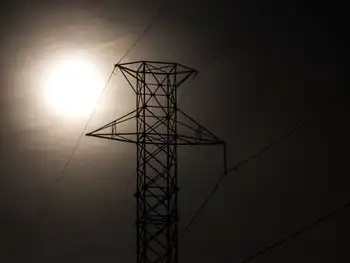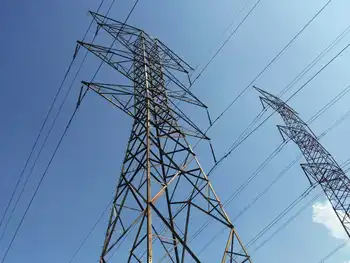Quietly, wind farms spread footprint in U.S.
By Reuters
Arc Flash Training CSA Z462 - Electrical Safety Essentials
Our customized live online or in‑person group training can be delivered to your staff at your location.

- Live Online
- 6 hours Instructor-led
- Group Training Available
But despite their imposing presence and the stark contrast with the rolling pastures and corn fields, the turbines have received a warm welcome here.
As Eric Chamberlain, who manages the wind farm for Wind Capital Group, eats lunch in a local restaurant, local people greet him with a "Hey Windy!" and many say they are happy to be using clean electricity.
"It doesn't pollute the environment, it provides tax revenue, creates jobs. I don't see a downside," said Chamberlain, who is something of a celebrity in this town of 1,400 people.
While growth in ethanol use as an alternative fuel has had a big impact on rural America, wind power has also been growing steadily for the past three years, with wind farms like this one springing up all over the windy expanse of the Great Plains and beyond.
While only 1 percent of U.S. electricity comes from wind, it is attracting so much support these days that many in the industry believe it is poised for a growth spurt.
"These are pretty heady times," said Randall Swisher, executive director of the American Wind Energy Association, which held an investment conference April 30 in Iowa that drew more than 600 attendees.
"People are finally starting to see the data about what is happening to the world's climate and that is really having an impact," said Swisher.
Last year, a record 3,100 turbines were installed across 34 U.S. states and another 2,000 turbines are now under construction from California to Massachusetts. In all, there are about more than 25,000 U.S. turbines in operation, an investment of $15 billion.
On May 12, the U.S. Energy Department said wind power could provide 20 percent of U.S. electricity by 2030, or 304 gigawatts, up from the current 16.8 gigawatts. Achieving that will require that wind turbine installations rise to almost 7,000 a year by 2017, the department said.
The industry appears poised to comply.
In March, GE Energy announced it had secured a $1 billion deal to supply 750 megawatts of wind turbines - enough to power about 200,000 households.
In April, Nebraska officials broke ground on a wind farm that would be the largest in that state, providing power for an estimated 25,000 homes.
Also in April, the electric company Wisconsin Public Service Corp. won approval from state regulators to construct a $251 million wind farm in Iowa to help it meet a state mandate that it boost its supply of renewable power.
In Texas, legendary oil man T. Boone Pickens has announced plans to invest in a wind farm that would provide enough electricity for about 1 million homes. Pickens' company, Mesa Power, this month ordered more than 600 wind turbines from GE to get started.
And, this year, Kansas became the first state in the nation to reject expansion of coal-fired plants specifically because of global warming worries. Gov. Kathleen Sebelius is recommending wind energy as an alternative and successfully fought legislative efforts to overrule her.
Wind Capital, based in St. Louis, Missouri, is a relatively small player. It operates three wind farms in Missouri and has plans for projects in 10 U.S. states. Among its backers are Irish renewable energy company NTR Plc, which invested $150 million in April, and a unit of Deere & Co, with a $200 million investment.
The firm leases land from farmers on which to build its turbines. In Rock Port, homes and businesses getting power from the municipal utility are now using wind energy, backed by conventional electricity supplies from the Missouri Joint Municipal Utility system.
Increasingly, states are mandating that utilities obtain a portion of their power through such renewable sources. Wind energy is also benefiting from a Production Tax Credit federal subsidy of 2 cents per kilowatt hour of electricity produced.
According to the American Wind Energy Association, this amounts to $4.5 billion over 10 years.
That is still far less than the $3.57 billion in annual subsidies enjoyed by the ethanol distillers under a 51 cents per gallon Ethanol Excise Tax Credit.
Supporters say along with helping the nation break a dependence on costly oil, natural gas and coal, they see wind energy as part of a base for "green-collar" employment, with jobs in manufacturing towers, blades and other components.
Illinois Sen. Barack Obama, who is seeking the Democratic nomination for president, has proposed investing $150 billion over the next decade for investments in alternative energy, including wind, solar and biodiesel. His rival for the nomination, Sen. Hillary Clinton is also proposing a $150 billon ten-year investment in a "new energy future."
Sen. John McCain, the Republican Party's presumed nominee for November's presidential election, has also said he supports wind energy. McCain even chose a wind-energy facility in Portland, Oregon, as the setting for a May 12 policy speech on global warming.
Critics argue that imposing wind turbines spoil landscapes and disrupt wildlife habitats, and such worries have dogged what would be the first U.S. offshore commercial wind-powered electricity generator, proposed to cover 28 square miles of shallow waters off the Massachusetts coast.
As well, there is the reality that sometimes the wind just doesn't blow. That means wind turbines cannot be relied on as a sole power source, but rather as a supplement. And transmission lines and grid systems have yet to be established across much of the windblown prairie.
But the greatest concern currently for the wind energy industry is that for all the public support, the Production Tax Credit is set to expire in December. U.S. lawmakers and President Bush have repeatedly failed to agree on how to fund an extension.
"We continue to push ahead because we believe that renewable energy does make a lot of sense and even policy makers at some point will have to realize something has to be done with $120 a barrel oil," said Michael Polsky, CEO of Invenergy LLC, a Chicago-based wind developer.
Since the $90 million Loess Hill wind farm in Rock Port came online in April, it has been a point of pride for residents that, over a year, the farm should generate enough power to exceed the town's consumption.
Farmer Todd Herron, who receives $5,000 a year from Wind Capital Group for hosting a spinning turbine on one of his corn fields, said there should be no argument against using wind to make electricity instead of coal or natural gas.
"This is a rural farming community," said Herron. "Our lives depend on the Earth. We've got to keep it in as good a shape as we can."











